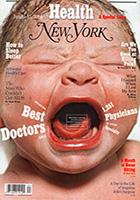Do you or someone you know have an ear shaped like a question mark? Ears come in every conceivable shape and size but one rare ear malformation is call the Question Mark Ear.
It looks like a question mark because there is an indentation between the upper two thirds of the ear and the earlobe, causing the outline of the ear to appear like a question mark. In some cases the upper portion of the ear is larger than normal which makes the question mark similarity even more striking. Don’t count on seeing too many of these; they are quite rare.

Do you or someone you know have an ear-shaped like a question mark? Ears come in every conceivable shape and size but one rare ear malformation is called the Question Mark Ear.
It looks like a question mark because there is an indentation between the upper two-thirds of the ear and the earlobe, causing the outline of the ear to appear like a question mark. In some cases, the upper portion of the ear is larger than normal which makes the question mark similarity even more striking. Don’t count on seeing too many of these; they are quite rare.
How can it be treated?
Fortunately, the question mark ear can be treated through a specialized type of Otoplasty.
During the consultation, your surgeon will inform you of what you should do and avoid. Adults can have their procedure under local anesthesia. Young children require general anesthesia. The indentation in the lower portion of the ear has to be filled in with a combination of cartilage for support and skin. Dr. Thorne most often uses a cartilage graft covered with a flap of skin from behind the ear. For milder cases, the cartilage can be taken from the conchal portion of the ear. While in severe cases, it is taken from the rib cage.
As mentioned above, the deformity is also known for the excess tissue in the upper part of the ear. So ear reduction techniques may be required. If the deformity is too severe, the ear is completely reconstructed using cartilage from the ribs in the same fashion used for children born without ears (microtia).
What to expect during recovery?
It is important to follow the post-procedure instructions given to you by your surgeon to reduce the risk of complications such as infection. After your otoplasty for question mark ears, your head will be loosely wrapped in padded bandages to protect your ears, soak up any drainage and help keep the repair in place. These bandages will then be removed after 4-5 days.
Dr. Thorne uses absorbable sutures, so you may not require a return visit for suture removal. He may also advise you to wear a loose headband every night for two weeks. Additionally, you can expect to go back to work within a week, while children can go back to school after a week.
There are many types of ear anomalies and if you wish to know more, don’t hesitate to set an appointment with us. Dr. Thorne has been treating people, both adults, and children, with all types of ear conditions for more than 30 years. He has the longest experience in ear reconstruction and otoplasty in North America.

Dr. Thorne is the Editor-in-Chief and the author of several chapters in Grabb and Smith's PLASTIC SURGERY, 7th Edition.
Ear Construction Chapter in PDF







